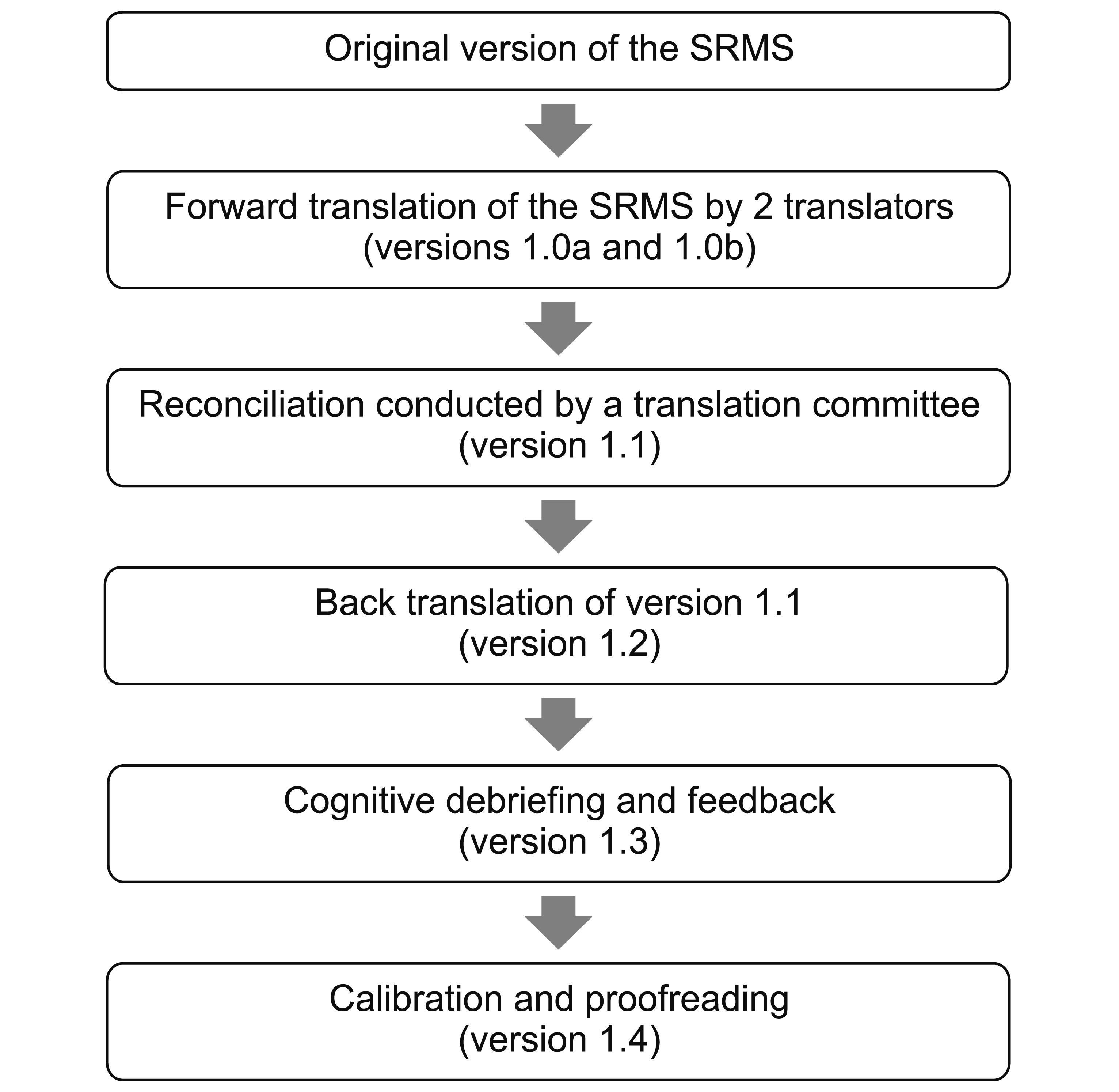Ann Rehabil Med.
2020 Feb;44(1):11-19. 10.5535/arm.2020.44.1.11.
Korean Version of the Stroke Rehabilitation Motivation Scale: Reliability and Validity Evaluation
- Affiliations
-
- 1Department of Rehabilitation Medicine, National Rehabilitation Center, Ministry of Health and Welfare, Seoul, Korea
- KMID: 2501042
- DOI: http://doi.org/10.5535/arm.2020.44.1.11
Abstract
Objective
To translate the Stroke Rehabilitation Motivation Scale (SRMS), developed to evaluate the motivation level of stroke patients during rehabilitation, into the Korean language and to verify the reliability and validity of the Korean version of SRMS (K-SRMS).
Methods
The K-SRMS was developed following a structured process that included translation, verification, compromise assessment, reverse translation, feedback, and final correction. K-SRMS reliability was evaluated by performing internal consistency and test–retest analyses. The reliability test was conducted in 50 stroke patients. Its validity was assessed by comparing the K-SRMS with the scale and performing exploratory factor analysis. The validity test was conducted in 102 stroke patients.
Results
The test–retest analysis showed good reliability, and the internal consistency of the K-SRMS was similar to that of the original version for all, except 4, items. Thus, these 4 items were excluded, and then the validity test was conducted. Pearson correlation analysis demonstrated that the K-SRMS score was significantly correlated with the BAS total score (Pearson r=0.207, p<0.05). In the exploratory factor analysis, K-SRMS items were categorized into 7 groups (factors), and factors 1 and 4 showed mutual concordance with K-SRMS subscales, including intrinsic motivation factors and amotivation, respectively.
Conclusion
The newly developed K-SRMS showed good reliability and validity. It could also be used as a tool to objectify the degree of motivation for rehabilitation among stroke patients in clinical care and research.
Keyword
Figure
Cited by 1 articles
-
The Korean Version of the Fugl-Meyer Assessment: Reliability and Validity Evaluation
Tae-lim Kim, Sung Hwan Hwang, Wang Jae Lee, Jae Woong Hwang, Inyong Cho, Eun-Hye Kim, Jung Ah Lee, Yujin Choi, Jin Ho Park, Joon-Ho Shin
Ann Rehabil Med. 2021;45(2):83-98. doi: 10.5535/arm.20225.
Reference
-
1. Langhorne P, Holmqvist LW; Early Supported Discharge Trialists. Early supported discharge after stroke. J Rehabil Med. 2007; 39:103–8.
Article2. Maclean N, Pound P, Wolfe C, Rudd A. Qualitative analysis of stroke patients’ motivation for rehabilitation. BMJ. 2000; 321:1051–4.
Article3. Maclean N, Pound P, Wolfe C, Rudd A. The concept of patient motivation: a qualitative analysis of stroke professionals’ attitudes. Stroke. 2002; 33:444–8.4. Tupper A, Henley S. Predictive factors in stroke outcome and implications for intervention. Int J Rehabil Res. 1987; 10:119–22.
Article5. Resnick B. Motivation in geriatric rehabilitation. Image J Nurs Sch. 1996; 28:41–5.
Article6. White GN, Cordato DJ, O’Rourke F, Mendis RL, Ghia D, Chan DK. Validation of the Stroke Rehabilitation Motivation Scale: a pilot study. Asian J Gerontol Geriatr. 2012; 7:80–7.7. Pelletier LG, Tuson KM, Fortier MS, Vallerand RJ, Briere NM, Blais MR. Toward a new measure of intrinsic motivation, extrinsic motivation, and amotivation in sports: the Sport Motivation Scale (SMS). J Sport Exerc Psychol. 1995; 17:35–53.
Article8. Mallett C, Kawabata M, Newcombe P, Otero-Forero A, Jackson S. Sport Motivation Scale-6 (SMS-6): a revised six-factor sport motivation scale. Psychol Sport Exerc. 2007; 8:600–14.
Article9. Scholten MR, van Honk J, Aleman A, Kahn RS. Behavioral inhibition system (BIS), behavioral activation system (BAS) and schizophrenia: relationship with psychopathology and physiology. J Psychiatr Res. 2006; 40:638–45.
Article10. Kim KH, Kim WS. Korean-BAS/BIS scale. Korean J Health Psychol. 2001; 6:19–37.11. Streiner DL. Starting at the beginning: an introduction to coefficient alpha and internal consistency. J Pers Assess. 2003; 80:99–103.
Article12. Jorm AF, Christensen H, Henderson AS, Jacomb PA, Korten AE, Rodgers B. Using the BIS/BAS scales to measure behavioural inhibition and behavioural activation: factor structure, validity and norms in a large community sample. Pers Individ Dif. 1998; 26:49–58.
Article13. Johnson SL, Turner RJ, Iwata N. BIS/BAS levels and psychiatric disorder: an epidemiological study. J Psychopathol Behav Assess. 2003; 25:25–36.14. Laver KE, Lange B, George S, Deutsch JE, Saposnik G, Crotty M. Virtual reality for stroke rehabilitation. Cochrane Database Syst Rev. 2017; 11:CD008349.
Article15. Shin JH, Ryu H, Jang SH. A task-specific interactive game-based virtual reality rehabilitation system for patients with stroke: a usability test and two clinical experiments. J Neuroeng Rehabil. 2014; 11:32.
Article16. Shin JH, Kim MY, Lee JY, Jeon YJ, Kim S, Lee S, et al. Effects of virtual reality-based rehabilitation on distal upper extremity function and health-related quality of life: a single-blinded, randomized controlled trial. J Neuroeng Rehabil. 2016; 13:17.
Article
- Full Text Links
- Actions
-
Cited
- CITED
-
- Close
- Share
- Similar articles
-
- On the Test of the Reliability and Validity of the Disabled's Motivation Scale for Rehabilitation
- Reliability and Validity of Korean-Version of Information Needs in Cardiac Rehabilitation Scale
- Stroke Impact Scale 3.0: Reliability and Validity Evaluation of the Korean Version
- Reliability and Validity of Korean Version of National Institutes of Health Stroke Scale: Multi-center study
- Standardization Study of Internet Addiction Improvement Motivation Scale


